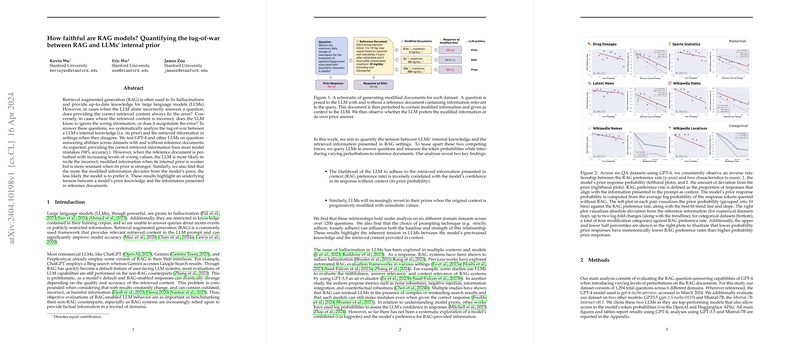An Analytical Gaze into the Dynamics of Retrieval Augmented Generation Frameworks and LLMs
Introduction
Retrieval Augmented Generation (RAG) enhances the performance of LLMs by augmenting their outputs with information retrieved from external documents. This compensates for LLMs' limitations in handling queries requiring up-to-date information or reducing hallucinated outputs. Notably, this research systematically examines how LLMs reconcile inconsistencies between their internally stored knowledge and the external information provided by RAG when the two sources offer conflicting details.
Analyzing Model Behavior in RAG Contexts
The paper meticulously explores the interplay between an LLM's pre-existing knowledge base and external information retrieved through RAG systems. Utilizing GPT-4 along with other prominent models, the research spans over 1200 questions across six domain-specific datasets. It uncovers that LLMs exhibit a higher likelihood of adhering to retrieved information when their internal confidence in their knowledge is low. Conversely, with stronger priors, LLMs tend to resist external misinformation, highlighting a nuanced tension in integrating RAG with LLMs.
Key Findings from the Study
- Model Adherence to RAG: There appears to be an inverse relationship between the model's internal confidence (prior probability) and its propensity to rely on retrieved information. Higher internal confidence correlates with decreased dependence on external data.
- Influence of Data Perturbation: As the level of deviation in retrieved data from the model's prior increases, LLMs progressively favor their own knowledge over the modified external information. This relationship maintains across variations in the prior knowledge's probability, suggesting inherent robustness in LLMs against misleading RAG inputs.
- Prompting Techniques and RAG Adherence: The paper further explores the impact of different prompting strategies on LLMs' RAG adherence. Results indicate that the phrasing of prompts significantly influences the model's reliance on RAG, with "strict" prompts enhancing adherence and "loose" prompts promoting skepticism towards retrieved content.
Implications and Future Directions
The nuanced understanding of LLM behavior in the context of RAG systems provides valuable insights for both theoretical exploration and practical applications of generative AI. It underscores the importance of carefully considering the model's internal confidence and the accuracy of retrieved information in designing effective RAG systems. Additionally, the observed influence of prompting strategies on RAG integration opens avenues for refining interaction paradigms between LLMs and external knowledge sources.
Moving forward, this research advocates for a more sophisticated analysis of the symbiotic relationship between LLM priors and RAG inputs. Further investigation into the mechanisms that govern this relationship could lead to advancements in model architecture, prompting strategies, and information retrieval techniques, enhancing the reliability and accuracy of LLM outputs in real-world applications.
Conclusion
This investigation into the dynamics between LLMs' internal knowledge and external information provided by RAG systems unearthed critical insights into the operational mechanisms of RAG-integrated LLMs. By scrutinizing the conditions under which LLMs either favor or disregard external inputs, the research charts a path for future advancements in the field. The observed interplay between model confidence, data deviation, and the impact of prompting techniques not only broadens our understanding of LLM capabilities but also propels us towards creating more sophisticated and reliable generative AI systems.
